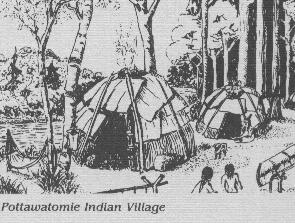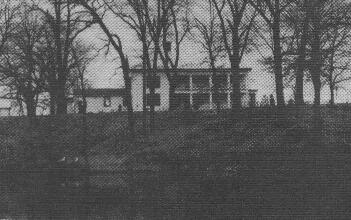

Pottawatomie Indian Village Maranatte House in Mendon -- where Treaty was signed in
1833 -- Patawattomies sold the last reservation lands.
This land we live on, the fertile valley of the St.
Joseph River, was wilderness - a vast and endless forest. Over it
lay a great silence broken only by the rushing wind and the running water.
It was land of rare beauty, countless lakes, burr oak plains, white oak
ridges, pines skirting the river, prairie ablaze with flowers.
For thousands of years ancient people wandered into
the valley and drifted out. These prehistoric peoples mysteriously vanished
leaving behind extensive earthworks, complex burial grounds, and unique
garden beds.
In the 1600's when the first white explorers ventured
into the valley they found living there peaceful Indians, the Pottawatomies.
For the past two hundred years the Indians had hunted, fished, and roamed
the prairies. The Potawatomies were a great Indian nation occupying
southern Michigan and northern Indiana. They were closely related
to the powerful Ottawas and Chippewas. Recognizing this relationship
they formed a loose federation calling themselves the "Brothers of Three
Fires."
Through the years the Indians watched the intrusion
of their land by explorers, missionaries, trappers, traders, soldiers,
and the onrush of the American pioneer. In the Chicago Treaty of
1821 signed by Gov. Cass, Top-in-a-Bee and major Pottawatomie Chiefs, most
of the southwestern Michigan south of the Grand River was sold to the American
government. From the vast lands which the Pottawatomies had occupied,
all that was left were a few isolated reservations and the Nattawa-seppe
reservation. It was prime fertile land, a tempting area to the land
hungry pioneer. In the Chicago Treaty of 1833, Gov. Porter tricked
the Indians with slick promises and the Pottawatomies sold the reservations.
Many Indians would not honor the treaty and refused to move off their land.
In 1840, General Brady, with troops from the United States Army, rounded
up the Indians and moved them across the Mississippi. Some Indians
not willing to move hid in the forest until the soldiers were gone but
their power and land was gone.
The St. Joseph River valley was a choice spot. The
fertile prairies were covered with grass four or five feet high.
The soil was rich and deep and forests of hard wood trees so dense the
sun scarcely came through. It was wild land, untamed.
The early pioneers were squatters putting up temporary
shelters and laying claim to many acres of land. Some were agents
or land spotters for wealthy men in the East. The land office opened
in White Pigeon in 1831.
In 1828, Jacob McInterfer came from Ohio and selected
a mile square section of land along the Rock River. He erected a
lean-to shelter, cleared land, planted corn and potatoes, and in the spring
brought his wife, Cathryn, and twelve children to live here. The
Richerts and the Sinnamans platted the village of Moab in 1830. Their
land lay south of Broadway along the west side of the St. Joseph River.
In 1830, George Buck purchased 800 acres on the east side of the St. Joseph
River. He built a large two-room log house for his wife, Martha,
and thirteen children.
Life was a challenge! Jacob McInterfer and George
Buck cleared the wilderness, streets were laid through the woods, and the
village of St. Joseph platted in 1830 (second district). They hoped
to be the center of county government but lost out to Centreville.
McInterfer started a saw mill on the Rock River. George Buck used
his large double cabin for a pioneer hotel, and constructed a ferry raft
to be towed across the St. Joseph River by rope and tackle. George
Buck's cabin (4th Street) became the social and political center of the
community. He was the first postmaster, and the first Justice of
the Peace. The first road from White Pigeon came to his cabin door.


Go to: Page 3

[top of page]